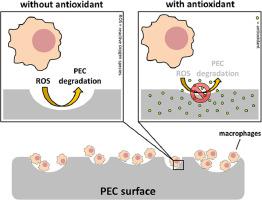Acta Biomaterialia ( IF 9.7 ) Pub Date : 2020-07-02 , DOI: 10.1016/j.actbio.2020.06.041 Adam Bohr 1 , Thais Leite Nascimento 2 , Necati Harmankaya 1 , Rayane Santa Cruz M de Q Antonino 2 , Moritz Beck-Broichsitter 3

|
Surface-eroding polymers are of significant interest for various applications in the field of controlled drug delivery. Poly(ethylene carbonate), as an example, offers little control over the rate of degradation and, thus, drug release, which usually conflicts with the requirements for long-acting medications.
Here, we challenged an option to decelerate the degradation of poly(ethylene carbonate) in vitro and in vivo. When polymer films loaded with distinct antioxidants (vitamins) along with the model drugs leuprorelin and risperidone were incubated in superoxide radical solution and phagocyte culture, the mass loss and drug release from the delivery vehicle was a function of the type and dose of the utilized antioxidant. Once the polymer surface was “attacked” by reactive oxygen species, the antioxidants were released on demand quenching the polymer-degrading radicals. Accordingly, specific combinations of polymer and radical scavengers resulted in controlled release medications with an extended “life-time” of one month or longer, which is difficult to achieve for poly(ethylene carbonate) in the absence of antioxidants. A comparable degradation and drug release behavior was observed when antioxidant-loaded poly(ethylene carbonate) films were implanted in rats. Furthermore, linear correlations were obtained between the mass loss of the polymer films and the released fraction of drug (with slopes close to 1), a clear indication for the surface erosion of poly(ethylene carbonate) in vitro and in vivo.
Overall, an addition of antioxidants to poly(ethylene carbonate)-based controlled drug delivery vehicles represents a reasonable approach to modify the performance of long-acting medications, especially when a “life time” of weeks to months needs to be achieved.
Statement of Significance
Surface-eroding poly(ethylene carbonate) (PEC) is of significant interest for long-acting injectable formulations. However, PEC offers only little control over the rate of degradation and, thus, drug release kinetics. We describe an option to decelerate the degradation rate of PEC in vitro and in vivo. When polymer films loaded with distinct antioxidants along with model drugs were incubated in superoxide radical solution, phagocyte culture and implanted in rats, their mass loss and drug release was a function of the type and dose of the utilized antioxidant. Accordingly, specific combinations of polymer and radical scavengers resulted in controlled release medications with an extended “life-time” of one month or longer, which is difficult to achieve for PEC in the absence of antioxidants.
中文翻译:

抗氧化剂介导的表面腐蚀聚碳酸亚乙酯降解和药物释放的控制。
对于可控药物输送领域中的各种应用,表面腐蚀聚合物引起了极大的兴趣。例如,聚碳酸亚乙酯几乎不能控制降解速率,因此不能控制药物释放,这通常与长效药物的要求相矛盾。
在这里,我们挑战了在体外和体内减速聚碳酸亚乙酯降解的选择。当将装有独特抗氧化剂(维生素)以及模型药物亮丙瑞林和利培酮的聚合物薄膜在超氧自由基溶液和吞噬细胞培养物中温育时,传递载体的质量损失和药物释放是所用抗氧化剂的类型和剂量的函数。一旦聚合物表面被活性氧“攻击”,抗氧化剂就会按需释放,从而淬灭聚合物降解基团。因此,聚合物和自由基清除剂的特定组合导致控释药物的“寿命”延长到一个月或更长,这在缺少抗氧化剂的情况下很难实现。当在大鼠中植入抗氧化剂负载的聚碳酸亚乙酯薄膜时,观察到了类似的降解和药物释放行为。此外,在聚合物薄膜的质量损失与药物释放比例(斜率接近1)之间获得了线性相关性,这清楚地表明了聚碳酸亚乙酯的表面腐蚀体外和体内。
总体而言,在基于聚碳酸亚乙酯的受控药物输送工具中添加抗氧化剂代表了一种改良长效药物性能的合理方法,尤其是当需要达到数周至数月的“生命周期”时。
重要声明
表面腐蚀的聚碳酸亚乙酯(PEC)对于长效可注射制剂非常感兴趣。但是,PEC几乎不能控制降解速率,因此不能控制药物释放动力学。我们描述了在体外和体内降低PEC降解速率的选项。当将装有独特抗氧化剂和模型药物的聚合物薄膜在超氧自由基溶液中孵育,吞噬细胞培养并植入大鼠体内时,它们的质量损失和药物释放是所用抗氧化剂的类型和剂量的函数。因此,聚合物和自由基清除剂的特定组合导致控释药物的“寿命”延长到一个月或更长,这在没有抗氧化剂的情况下很难实现。



























 京公网安备 11010802027423号
京公网安备 11010802027423号